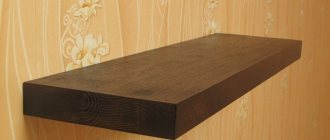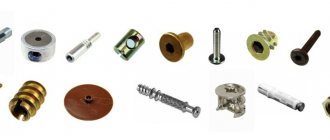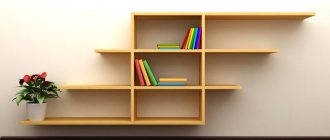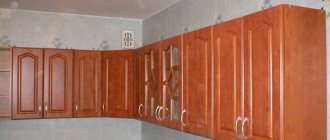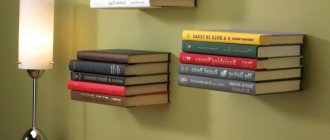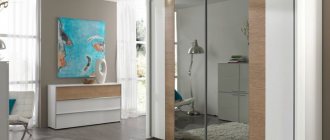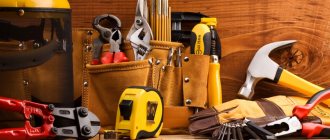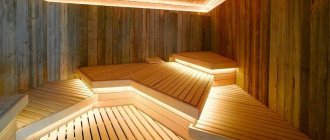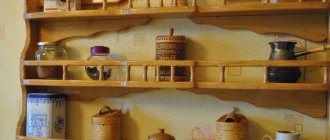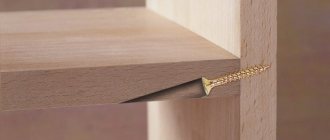The main part of each cabinet is the shelves, thanks to which compact storage of various items is organized. A long and high-quality service life directly depends on the reliability and correct fastening of the shelves.
A long and high-quality service life directly depends on the reliability and correct fastening of the shelves.
Fixing the hanging shelves in the closet will not be difficult; you just need to make markings, observing the horizontal levels. Otherwise, the weight will be unevenly distributed over the surface of the shelf, and the load on one mount will be much greater than on the other. In the future, it will break and the shelf will fall, there is a possibility that the cabinet wall will ultimately be severely damaged.
The main part of each cabinet is the shelves, thanks to which compact storage of various items is organized.
Types of fastenings for cabinet shelves
The simplest option is self-tapping screws. They come with hidden caps and press washers.
Screws have a two-digit marking: the first number indicates the diameter of the thread, the second indicates the total length.
Screws have a two-digit marking: the first number indicates the diameter of the thread, the second indicates the total length. The higher the values of these parameters, the stronger the load on the screw can be.
To avoid cracks on the product, mounting holes should be made with a drill of a smaller thread diameter.
For installation, use a screwdriver or screwdriver. To avoid cracks on the product, mounting holes should be made with a drill of a smaller thread diameter.
Fixing the hanging shelves in the closet will not be difficult; you just need to make markings, observing the horizontal levels.
Advantages of fastening shelves with self-tapping screws:
- ease of use;
- low cost.
The simplest option is self-tapping screws.
- the screw head is visible (it can be disguised with special plugs);
- low permissible load;
- after several cycles of assembly and disassembly, the fixing properties will be lost.
For installation, use a screwdriver or screwdriver.
Euroscrews, or so-called confirmed screws, differ from simple screws in their larger thickness, thread pitch, cylindrical head and blunt end.
For shelves that will not be subjected to heavy loads, you can use any type of fittings.
The most popular are European screws in sizes 50 and 75 millimeters. The first type is good for working with 16 mm thick chipboard. The second one is advisable to apply to 26 mm chipboard.
Using a special drill, you have the opportunity to simultaneously drill both elements for the screw thread and head.
To install the shelves, use a hexagon, a confirmation drill, or two ordinary drills with a diameter of 5 millimeters for the thread and 7 for the head. Using a special drill, you have the opportunity to simultaneously drill both elements for the screw thread and head.
Euroscrews, or so-called confirmed screws, differ from simple screws in their larger thickness, thread pitch, cylindrical head and blunt end.
Advantages of fastening with Euroscrews:
- parts can be tied together;
- strong fixation;
- They look more aesthetically pleasing than self-tapping screws.
Two dowels and a Euroscrew have a more aesthetic appearance than two Euroscrews, and the reliability of the fastening will be much higher.
- the cap is visible on the surface (easy to hide with plugs),
- like simple screws, they are unstable to assembly and disassembly.
To install the shelves, use a hexagon, a confirmation drill, or two ordinary drills with a diameter of 5 millimeters for the thread and 7 for the head.
It is more expedient to use furniture dowels in combination with tightening elements: two dowels and a Euroscrew have a more aesthetic appearance than two Euroscrews, and the reliability of the fastening will be much higher.
There are models without footings - then the rod is screwed into the part, but such fixation is less resistant to repeated installation and disassembly.
An eccentric coupler, or the so-called mini-fix, which consists of a rod, a fitting and an eccentric. There are models without footings - then the rod is screwed into the part, but such fixation is less resistant to repeated installation and disassembly.
When choosing accessories for shelves, you should take into account the material from which they are made and the method of desired fastening.
The eccentric can be located in a metal or plastic decorative casing. You can choose a color that suits your furniture. It has a very original appearance, and there is no need to hide it.
Corner screed, despite a number of advantages, is practically not used in modern furniture models.
To install a connection using mini-fixes, you need a 5 mm drill with a stop and a 20 mm Forstner cutter.
For shelves that will not be subjected to heavy loads, you can use any type of fittings.
- invisible from the outside of the furniture;
- there is no need to hide it inside the product;
- you can tighten the parts;
- available connection formation;
- ease of fixing shelves;
- Reusable installation and disassembly is not prohibited.
Drilling the wall
Craftsmen use a hammer drill, but for a home workshop, an electric drill with a power of ≥ 600 W is usually purchased. It is advisable to have a tool with continuously adjustable speed and a quick-release chuck. It is convenient if a hammer drilling function is provided, making the activity easier.
Wooden, foam concrete walls, as well as partitions made of plasterboard, can be drilled using a regular drill. More durable materials - concrete, brick - will require a carbide drill with pobedite surfacing at the end. If a hole > 15 cm in length is expected, then a hammer drill with a drill is used.
Holes in the walls have to be drilled for different purposes. They are mainly needed for securely fixing wall cabinets. At the preparation stage, the wiring diagram must be clarified to avoid damage. The drill gets very hot during operation, so it needs to be dipped in water periodically.
The brick should be drilled at low (up to 400) speeds in impact mode, pressing quite firmly on the handle and holding the tool strictly vertically. It is more difficult to work with high-strength concrete, since the Pobedit drill often rests on the reinforcement. To pass the obstacle, it is replaced with a regular drill. If a strict straight line of the hole is not a prerequisite, then you can shift the drilling direction. Stones in concrete are crushed with a narrow chisel inserted into the hole, hitting it with a hammer.
When placing the cabinet on a tiled wall, first remove the glaze in the designated areas with a sharp object. To make a hole of a given depth, you can take a piece of cylindrical cambric of the required diameter and length, put it on the drill, resting it tightly against the chuck.
Expert advice: If you can’t find a suitable tube, then ordinary insulating tape, which is applied to the drill in several turns, will help. This technique will eliminate the need to constantly monitor the depth of the drilled hole.
Choosing accessories for fastening shelves
Shelves in bookcases and linen closets are mainly made of chipboard, but metal or glass can be used in kitchen units. Therefore, when choosing accessories for shelves, you should take into account the material from which they are made and the method of desired fastening.
You can choose a color that suits your furniture.
For shelves that will not be subjected to heavy loads, you can use any type of fittings.
Glass shelves should only be mounted on special overhead holders. Inside they are a rubber gasket that prevents deformation on the fragile glass surface. If there will be a large load on the shelves, it is better to use bracket holders.
Shelves in bookcases and linen closets are mainly made of chipboard, but metal or glass can be used in kitchen units.
Currently, the market offers a huge selection of various models of fastenings, retractable and rotating mechanisms, which are not difficult to install yourself. Choose only high-quality fittings - they will serve you faithfully for many years.
An eccentric coupler, or the so-called mini-fix, which consists of a rod, a fitting and an eccentric.
Rustic Bathroom Shelves
If it's time to modernize your interior, shelves with hidden fastenings in the Provence style are the perfect decor. She creates exclusively her own, unique home comfort. And at the same time it seems to be floating in the air! Its artsy yet simple appearance will brighten up the bathroom and any nook that needs storage space.
This shelf model installs as a floating shelf and is reinforced for added strength, making it a great storage option for collectibles, photos, keepsakes and glassware. The design is inexpensive and requires very few materials.
Advice. You should avoid last-minute shopping trips; it is better to prepare materials in advance.
VIDEO: Closet shelves | Methods of fastening cabinet furniture shelves | #edblack
At the last stage of self-assembly of furniture, the question arises of attaching various shelves. Fittings for shelves consist of two main elements: holders, that is, fastening elements, and limiters that prevent various objects from falling from the shelves.
Accessories for various types of shelves
Types of shelves
All shelves can be divided according to two criteria:
- by the material from which they are made;
- according to the method of fastening.
Types of materials used to make shelves
Currently, furniture shelves can be made from:
- tree. They are mainly installed in country houses, where they fully match the surrounding interior or under heavy items;
Wooden shelves fit perfectly into the interior of country houses
- Chipboard. Shelves made of this material are used to furnish the interior space of linen closets and bookcases;
Chipboard is the most popular material for making modern shelves
- glass They are used as separate interior elements for storing souvenirs or photographs, and for storing dishes in living room cabinets;
Glass shelves are used for storing souvenirs or in bathrooms
- metal Metal shelves are mostly used in kitchen furniture. They are ideal for storing everyday utensils.
Metal shelves can most often be found in the kitchen.
Types of shelves depending on the method of their fastening
According to the method of fastening, all shelves can be divided into:
- stationary shelves installed in cabinets and on walls;
Stationary shelf in the dressing room
- pull-out shelves. Used to create additional sections in tables or to increase comfort in cabinets;
Pull-out type shelves are commonly used in desks and cabinets
- rotating shelves. Mostly installed in kitchen units or for storing shoes.
Rotating radial shelf
How to hang a shelf on drywall
Page navigation
Often home craftsmen are faced with the task of hanging a lamp, hanger, shelf or TV on a plasterboard wall. But many of them are quite justifiably afraid that the wall will begin to crumble and crumble due to drilling and other manipulations. Accordingly, all work must be carried out with caution, following the recommendations below.
Accessories for stationary shelves
Stationary shelves are attached using holders, which come in several types:
- overhead, that is, the holder is mounted to the wall or cabinet facade and a shelf is placed on it, which can be attached to the holder or simply lie freely. Mainly used for fastening wooden shelves and chipboard shelves;
Overlay shelf holder with fastening
- mortise or hidden. Used for fastening wooden and chipboard shelves. Installed inside the product;
- bracket holders. Used for shelves that carry heavy loads;
Bracket type shelf holder
- holders for glass shelves. They are a type of overhead, but can only be used for shelves made of glass. There is a rubber gasket inside the holder that protects the glass surface from deformation.
Preparing for work
Before you start attaching kitchen shelves, you need to prepare all the necessary conditions for this. Firstly, it is desirable that the walls are smooth and even.
Before starting work, you should prepare the wall surface.
If you plan to install it in a corner kitchen, then the angle should be straight - exactly 90 degrees. It is necessary to start fastening only after all electrical installation work has been completed.
In addition, the wall must be ready for installing shelves - if you plan to wallpaper or paint, then you need to finish it in advance.
First you need to make repairs on the kitchen, then hang the shelves.
Accessories for pull-out shelves
Furniture fittings for the latch shelf mainly consist of the following parts:
- guide elements;
- rollers moving along these guides.
There are several types of fittings:
- separate mechanisms that, when assembled, form a single whole;
- special designs with all built-in devices;
- tandem boxes, manufactured together with the shelf.
Installation of retractable fittings
To install the sliding shelf fittings you will need:
- measuring and marking mechanisms;
- drill;
- screwdriver
Installation of fittings begins with marking. To do this, follow these steps:
- The guides are disassembled into two parts. One part is subsequently attached to the furniture frame, and the other directly to the shelf;
- Holes for attaching the mechanism are marked on the frame and shelf.
The installation process then includes:
- drilling holes for fastening elements of the retractable mechanism;
- installation and fastening of mechanism components.
After installation, if necessary, final adjustment of the retractable fittings is made using special bolts.
Attaching the guide to furniture
Shelf supports-ties
The universal combination of shelf support and tie (SI 03 + rod VE08; 2574) not only holds the shelf, but also tightens the structure. The fashion for this model was introduced when it used such a shelf holder in the Modula furniture system (prefabricated structures, the design of which can easily be changed in accordance with the client’s wishes). This model consists of two parts: a metal rod and a plastic part. The metal rod is partially screwed into the side wall. The plastic part is driven into a pre-drilled hole in the shelf (20 or 15 mm depending on the shelf holder model). When assembling furniture, the shelf is snapped onto the head of the rod, and the entire structure is rigidly fixed.
Until now, some furniture production uses a cast metal corner - a screed, which often holds shelves. It securely fastens all furniture structures and does not require high-precision equipment. But it looks rather unattractive, so it is suitable exclusively for internal fastenings.
In sliding wardrobes, all structures are attached to corner ties, but not metal, but plastic. Plastic corners (UM) do not require pre-prepared holes; they are fastened with an ordinary screw and then closed with a lid. They look neat, and the wide range of colors (there are 12 colors in the MDM warehouse program) allows you to select a corner to match the chipboard. A plastic tie is unlikely to fit luxury furniture, but it is perfect for interior shelves and fixtures.
Accessories for rotating shelves
The fittings for rotating shelves include:
- upper and lower fastening of the rotation axis;
- the axis of rotation, which is a telescopic metal pipe, that is, the height of the column can be changed in accordance with the dimensions of the cabinet;
- shelf mounting flanges.
Installation of a rotating shelf
In order to properly mount a rotating shelf, you must:
- choose a place to attach the rotation axis in such a way that the installed shelf can move freely inside the cabinet;
- secure the upper and lower connecting structures (simply screwed to the bottom and top of the cabinet, respectively);
- establish the axis of rotation by inserting the pipe into the fixed flanges;
- bolt the shelf fastening to the axle;
- install the shelf itself.
Properly installed rotating shelf
Thus, the choice of hardware for shelves should be based on the material from which it is made and the method of fastening the product. In stores you can find many different options for overhead, mortise holders, retractable and rotating mechanisms, the installation of which does not cause any difficulties.
Shelves are the main element of filling a closet. They are arranged in such a way as to place things and objects in the most rational way. The fastening of shelves in the closet should ensure their reliable fixation. The bodies of wardrobes and kitchen cabinets, made of laminated chipboard, have an artificial structure made of glued sawdust. Therefore, the fastening of elements in various filling options must take this feature into account.
Types of fastenings
Manufacturers of furniture fittings offer various types of fasteners for shelves. Each of them corresponds to a specific installation method inside the cabinet. We will not consider fittings for pull-out shelves and rotating structures, but will focus on classic stationary options.
The most famous and common elements of such fastenings are:
- Euroscrew (confirmed).
- Rastex (minifix).
- Rafix.
- Shelf support.
- Dowel.
- Corners.
Brackets are also reliable supports for shelves, but they are not used in furniture production due to their bulkiness and unaesthetic appearance.
Euroscrew
Euroscrew or confirmat is used to connect chipboard parts to each other. Its length is 50 mm, diameter 6.4 mm. Holes for confirmations are made with a special countersink drill. Its length and diameter are equal to the dimensions of the Euroscrew.
The drill is slightly narrower than a European screw. When screwed in with a hexagonal driver, the confirmation spiral firmly cuts into the chipboard, forming a rigid and reliable connection between the shelf and the cabinet wall. The countersink at the upper end of the drill has a reaming collar, which flares the entrance hole under the countersunk. Thanks to this, the confirmation cap does not protrude above the surface of the chipboard.
The disadvantages of fasteners include the following:
- the screw heads have to be covered with adhesive circles or plastic plugs, and this somewhat spoils the appearance of the cabinet;
- This type of fixation does not allow placing shelves with a partition on the same center line. Horizontal slabs can only be installed vertically.
Rastex
The eccentric coupler consists of an eccentric sleeve and a dowel-screw. Rastexes are otherwise called minifixes and allow you to secure a shelf without visible fasteners.
The figure shows the technology for installing rastex. The rotary sleeve clamps the head of the dowel-screw. To secure the shelves, bushings are inserted into the horizontal plane of the slab from below. The whole operation consists of several stages:
- The hole for the eccentric is drilled with a special cutter ø 15 mm at a distance of 34 mm from the edge of the part to the center of the bushing. The working depth is 13 mm.
- Insert the eccentric with the cutout inward.
Stages of work
Preparing the wall
Before you start hanging cabinets or shelves, you need to do some preparation.
- The first step is to level the wall, since any unevenness will negatively affect the installation work.
- It is necessary to complete all electrical work - installation of sockets and lighting.
- All finishing work must be completed.
Kitchen finishing is necessary when purchasing an apartment in a new building or a major renovation.
Additional Information:
A new building may shrink for the first time in years, so to hide unevenness, you can purchase a plastic kitchen apron that is attached to liquid nails or self-tapping screws.
It’s easier to install a frame for future shelves on prepared walls
Hanging on a mounting plate (rail)
Before you begin installing the cabinets, you need to take into account that there will be a gap between the wall and the furniture.
It is necessary that this distance be the same both above and below. An additional rail needs to be installed at the bottom of the cabinet.
The mounting plate is level and attaches well to the wall.
This canopy option has several advantages over loops and hooks. Marking for the mounting rail is much simpler, and installing the cabinets is also easier. The hangers can also be adjusted. There will be no gaps between the cabinets, which will result in an even row. In addition, such a canopy can withstand any load, due to the fact that it is distributed evenly.
The main problem with using a mounting rail is the gaps between the wall and the cabinet.
However, there are also a number of disadvantages. Firstly, the cost is not cheap. Secondly, the gaps that form between the wall and the furniture.
Hanging corner
The first step is to dismantle the front doors, trim the back wall and secure the hooks. After this, you need to lean the set against the wall and mark the boundaries.
Take your time to hang the cabinet, follow the instructions.
The next step is to measure the distance from the top of the furniture to the top of the tire using a mounting rail. The difference between these two indicators should be noted on the wall and then the upper border of the batten and the parallel first line should be drawn.
The shelves need to be fastened well so that they last longer.
Using the mounting rail you need to make holes. You need to screw in dowels and screws, secure the rail and install the corners. The last step is to install a shelf or cabinet.
If the installation is done correctly, the shelves will hang evenly and delight the owners.
Hanging with loops
In order to hang cabinets using this method, you need to prepare hinges and other types of fasteners.
- After determining the upper limit, you need to draw a horizontal line along the entire length of the shelf or cabinet.
- Using a water level, you can check whether it was applied accurately.
- On this line you need to mark the location for the hole that will be used to install the fastener.
- We install the fasteners themselves.
- You need to prepare regular hinges on furniture. They may have a slight horizontal shift.
- Next, hang a cabinet or shelf, after which you can mark the second point for the hole. The cabinet is removed again.
- The actions are performed again.
- After all the work is completed, furniture and various decorative elements and accessories are installed.
Attaching cabinets in the kitchen is not a complicated process, but you should follow the rules.
Interesting interior design
Modern designers offer a large number of diverse and unusual solutions for how you can originally fit a non-standard shelf into your kitchen interior design. On the market you can find products of different sizes, shapes, with different functionality and other parameters.
Custom shelves in the kitchen attract the attention of guests.
If you want something truly exclusive, you can always make the product to order, and then the kitchen interior design will turn out to be truly interesting and unique.
In a small kitchen it is better to make small hanging shelves.
